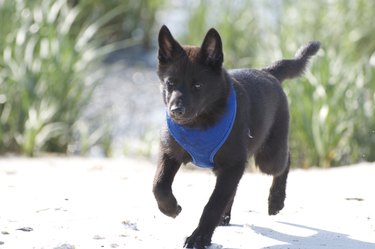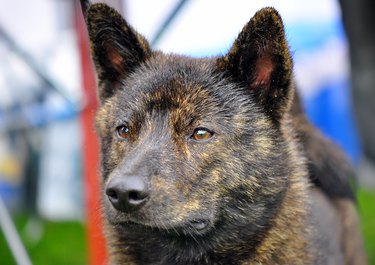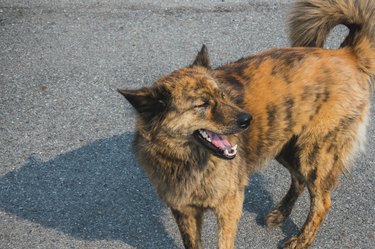
Adopting a dog is a huge commitment. Before settling on a breed, you need to find the right one for you. One that fits your lifestyle! Details like size, energy level, and personality can really affect not only your home but the happiness of your new pet. If you have the right kind of life for an intelligent, loyal, and at times reserved dog, then you might want to consider one of the Japanese dog breeds, the Kai Ken.
Kai Ken history
Video of the Day
The Kai Ken dog breed is a native of Japan. The Kai was wild and lived in the mountains in the Kai province, which is on an island. The Kai were geographically isolated by mountains and is therefore believed to be the purest of all Japanese breeds. Traditional writings describe the Kai as natural hunters, and they have been known to swim and climb trees in pursuit of their prey. They were first used by the hunters for tracking deer and wild boars.
Video of the Day
In Japan, the Kai is highly regarded. The Japanese describe the Kai as a trustworthy guardian and extremely devoted to his master. There is high regard and admiration for this breed. Some say a Kai will lay down its life to protect its master. In Japan, the Kai is very loved and protected. The Kai is designated a natural monument in Japan.
The Kai was recognized in 1934 by the Japanese Kennel Club. An interesting fact is that because of the language barrier and the fact that this is a rare dog breed, there is very limited information on the Kai dog.
Kai Ken characteristics

The Kai Ken is in the working group alongside dog breeds like the Akita, golden retriever, Labrador retriever, and the Siberian husky. It is a member of the American Kennel Club's (AKC) Foundation Stock Service.
The Kai Ken is a spitz-type, medium-sized dog with an adult male weighing 30 to 40 pounds and growing 18.5 to 19.5 inches tall. Females are a bit smaller and weigh 25 to 35 pounds and grow 15.5 to 17 inches tall. The Kai Ken dog has a sturdy build with a wedge-shaped head and a tapered muzzle. They have muscular shoulders and thighs and their sturdy legs are quite powerful.
Kai Ken has a thick tail and a double coat with a brindle coat pattern. The AKC breed standard recognizes three colors: medium brindle (chu-tora), black brindle (kuro-tora), and red brindle (aka-tora).
Kai Ken temperament & training
Breed is not a reliable indicator of personality, however, the Kai is highly intelligent and learns quickly. They are similar to other Japanese breeds in the fact that they are highly intelligent, however, they are not as independent and are more eager to please their owners.
These dogs are friendly and affectionate with family members but may need some supervision around young children. A Kai Ken is a vigilant watchdog and tends to be reserved with strangers.
Early socialization is recommended for these dogs as well as obedience training using positive reinforcement methods. The Kai Ken is a hunting dog and, even with obedience training, may give in to prey drive, so it is best not to let them off-leash unless they are in a safe, enclosed space.
Ken Kai grooming
Ken Kai has a medium-length coat and the undercoat sheds twice each year. Daily brushing is recommended while they are shedding, but for the rest of the year, an occasional brushing and bath is sufficient to maintain a clean and healthy coat.
Ken Kai exercise & health
The Ken Kai is an athletic dog with a medium energy level. Make sure they get daily exercise whether that be a walk, playtime in the yard, or even a chasing a ball around the house. Teaching your Ken Kai new tricks not only burns off energy but also helps offer mental stimulation. With proper exercise, the Ken Kai is suitable for apartment living.
The expected lifespan of the Kai Ken is 12 to 15 years. They tend to be healthy dogs, but there are some health issues to be aware of including luxating patella, seizures, and allergies. Responsible breeders will test their breeding stock and puppies for these health problems.
Kai Ken puppies

Kai Ken puppies reach their full adult size by the time they are 15 months of age, however, most of their growth occurs in the first year of life. At 6 months of age, they will be about two-thirds of their adult size, weighing 16.5 to 26.4 pounds. They will be 95 percent of their adult size when they are 12 months of age and continue to fill out to their adult weight during the next few months.
Read more about German Shepherds. Read more about different working dogs.